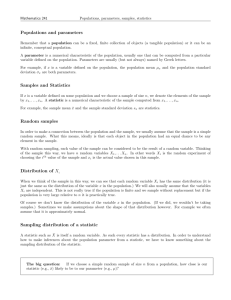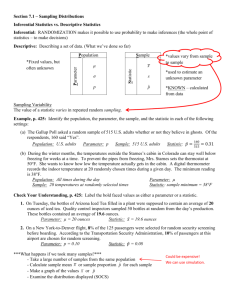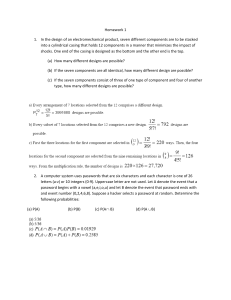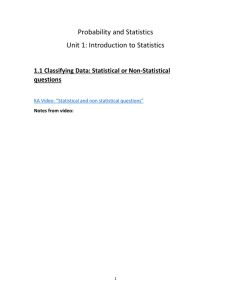QBM117 Business Statistics
advertisement
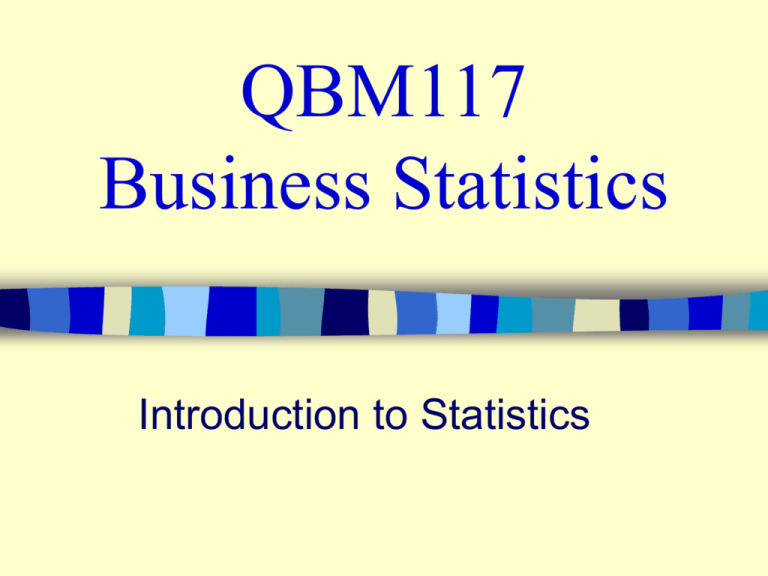
QBM117 Business Statistics Introduction to Statistics Objectives • To present a broad overview of statistics and its applications • To distinguish between a population and a sample • To distinguish between a parameter and a statistic • To distinguish between inferential statistics and descriptive statistics Statistics • Statistics is the science of collecting, organising, presenting, analysing and interpreting data. • Statistics is often described as the science of decision making in the face of uncertainty. • Statistics is the scientific method that enables us to make effective decisions based on data. Business Statistics • Statistics can be used in many fields of work and research. • Particularly in business, a major reason for collecting, organising, presenting, analysing and interpreting data is to give managers and decision makers a better understanding of the business environment. • This then allows them to make more informed and better decisions. Applications of Business Statistics Statistics may be applied in: Accounting • to select samples for auditing purposes Economics • to analyse and predict the future of the economy Finance • to track trends in financial measures over time Applications of Business Statistics Management • to manage and constantly improve production processes Marketing • To conduct marketing research to decide whether and how they should market a product Populations and Samples • In many situations, data are sought for a large group of items (individuals, stocks, voters, households, products, customers, and so on). • Because of time, cost and other restrictions, data are collected from only a small portion of the group. • The large group in a particular study is called the population, and then smaller group is called the sample. Example 1 Suppose that a nationwide referendum is to be held in two weeks time where 10 million voters will indicate whether or not they are in favour of uranium mining. You are given the task of predicting what the outcome of the referendum might be. To do this you could spend an enormous amount of time, money and effort to canvas the opinion of every eligible voter. Instead, a sample of voters could be taken from the population of eligible voters, and the voting intentions of those in the sample recorded. An estimate of the number of voters in the population who will vote for either choice could be based on the information from the sample. Populations and Samples • A population is the entire collection of items about which information is desired. • A sample is a subset of the population that we collect data from. Example 2 (Exercise 1.3 from text) A politician who is running for the office of mayor of a city with 25 000 registered voters commissions a survey. In the survey, 48% of the 200 registered voters interviewed say the planned to vote for her. What is the population of interest? The population of interest is the 25 000 registered voters. A politician who is running for the office of mayor of a city with 25 000 registered voters commissions a survey. In the survey, 48% of the 200 registered voters interviewed say the planned to vote for her. What is the sample? The sample is the 200 registered voters who were interviewed. Parameters • A parameter is a number that describes a population. • Examples are - population mean, μ - population standard deviation, σ - population proportion, p • A parameter is a fixed number. Parameters • A statistic is a number that describes a sample. • Examples are - sample mean, x - sample standard deviation, s - sample proportion, p̂ • A statistic is a variable whose value varies from sample to sample. Example 2 revisited A politician who is running for the office of mayor of a city with 25 000 registered voters commissions a survey. In the survey, 48% of the 200 registered voters interviewed say the planned to vote for her. Is the value 48% a parameter or a statistic? It is a statistic as it is a descriptive measure obtained from the sample. Descriptive and Inferential Statistics Statistics can be subdivided into two basic areas: • Descriptive Statistics • Inferential Statistics Descriptive Statistics • Most of the statistical information in newspapers, magazines, reports, and other publications consists of data that are summarized and presented in a form that is easy for the reader to understand. • Such summaries of data are referred to as descriptive statistics. Descriptive Statistics • Descriptive Statistics involves collecting, organising, summarising and presenting numerical data. • This includes - graphical displays - condensation of data into tables - calculation of summary measures Inferential Statistics • Because populations are very large, it is impractical and expensive to investigate or survey every member of a population. • It is far easier and cheaper to take a sample from the population of interest and to draw conclusions about the population based on the information provided by the sample. • Inferential Statistics involves drawing conclusions about a population based on the sample information. Inferential Statistics • In practice we usually don’t know the value of a population parameter. • We take a sample from the population of interest and calculate the sample statistic. • We then use the sample statistic to estimate the parameter of interest. • This is known as statistical inference. Example 3 A survey of starting salaries for 2000 tertiary graduates with degrees in economics was conducted in April 2001. The survey reported on average annual starting salary of $30 000. This survey result was based on a nationwide sample of 400 tertiary graduates who had accepted job offers during December 2000. What is the population of interest? The population of interest is 2000 tertiary graduates with degrees in economics. A survey of starting salaries for 2000 tertiary graduates with degrees in economics was conducted in April 2001. The survey reported on average annual starting salary of $30 000. This survey result was based on a nationwide sample of 400 tertiary graduates who had accepted job offers during December 2000. What is the sample? The sample is the 400 tertiary graduates surveyed. A survey of starting salaries for 2000 tertiary graduates with degrees in economics was conducted in April 2001. The survey reported on average annual starting salary of $30 000. This survey result was based on a nationwide sample of 400 tertiary graduates who had accepted job offers during December 2000. Is the average annual salary of $30 000 a parameter or a statistic? It is a statistic as it is the average annual starting salary of the sample. Example 4 A telemarketing firm in Sydney uses a device that dials residential telephone numbers in that city at random. Of the first 100 numbers dialled, 43 are unlisted. This is not surprising, because 52% of all Sydney residential phones are unlisted. What is the population? The population is all Sydney residential phones. A telemarketing firm in Sydney uses a device that dials residential telephone numbers in that city at random. Of the first 100 numbers dialled, 43 are unlisted. This is not surprising, because 52% of all Sydney residential phones are unlisted. What is the sample? The sample is the first 100 numbers dialled. A telemarketing firm in Sydney uses a device that dials residential telephone numbers in that city at random. Of the first 100 numbers dialled, 43 are unlisted. This is not surprising, because 52% of all Sydney residential phones are unlisted. What is the parameter? The parameter is the proportion of Sydney residential phones that are unlisted, i.e. 52%. A telemarketing firm in Sydney uses a device that dials residential telephone numbers in that city at random. Of the first 100 numbers dialled, 43 are unlisted. This is not surprising, because 52% of all Sydney residential phones are unlisted. What is the statistic? The statistic is the proportion of Sydney residential phones in the sample that are unlisted, i.e. 43% (43 out of 100). Example 5 A golf ball manufacturer wishes to know how far its newly designed super fly golf ball will go. What is the population of interest? The population of interest is all super fly golf balls produced by the manufacturer. A golf ball manufacturer wishes to know how far its newly designed super fly golf ball will go. Suggest possible reasons for taking a sample? It would take too much time and money to test each super fly gold ball. And it is unlikely that a super fly golf ball can be sold after it has been tested. So, if every golf ball was tested, there would be no golf balls to sell. A golf ball manufacturer wishes to know how far its newly designed super fly golf ball will go. What is the parameter of interest? The parameter of interest is the average distance a super fly golf ball travels after it is hit. A golf ball manufacturer wishes to know how far its newly designed super fly golf ball will go. What statistic might you calculate from the sample? The statistic to calculate is the average distance travelled by the super fly golf balls in the sample. Example 6 (Exercise 1.4 from text) A manufacturer of computer chips claims that less than 10% of his products are defective. When 1000 chips were drawn from a large production run, 7.5% were found to be defective. What is the population of interest? The population of interest is all of the computer chips produced by the manufacturer. A manufacturer of computer chips claims that less than 10% of his products are defective. When 1000 chips were drawn from a large production run, 7.5% were found to be defective. What is the sample? The sample is the 1000 chips drawn from the large production run. A manufacturer of computer chips claims that less than 10% of his products are defective. When 1000 chips were drawn from a large production run, 7.5% were found to be defective. What is the parameter? The parameter is the proportion of defective chips in the population, i.e. the proportion of defective chips produced by the manufacturer. A manufacturer of computer chips claims that less than 10% of his products are defective. When 1000 chips were drawn from a large production run, 7.5% were found to be defective. What is the statistic? The statistic is the proportion of defective chips in the sample, i.e. 7.5%. A manufacturer of computer chips claims that less than 10% of his products are defective. When 1000 chips were drawn from a large production run, 7.5% were found to be defective. Does the value 10% refer to the parameter or the statistic? The value 10% refers to the parameter. A manufacturer of computer chips claims that less than 10% of his products are defective. When 1000 chips were drawn from a large production run, 7.5% were found to be defective. Is the value 7.5% a parameter or a statistic? The value 7.5% is a statistic as it is the proportion of defective chips in the sample. A manufacturer of computer chips claims that less than 10% of his products are defective. When 1000 chips were drawn from a large production run, 7.5% were found to be defective. Explain briefly how the statistic can be used to make inferences about the parameter to test the claim. The sample proportion of defective chips (7.5%) is less than 10% and hence there is evidence to support the manufacturer’s claim. Check your understanding • What is the difference between a sample and a population? • What is the difference between a statistic and a parameter? • What is the difference between descriptive and inferential statistics? Reading for next lecture S&S Chapter 2, Sections 2.1-2.3

